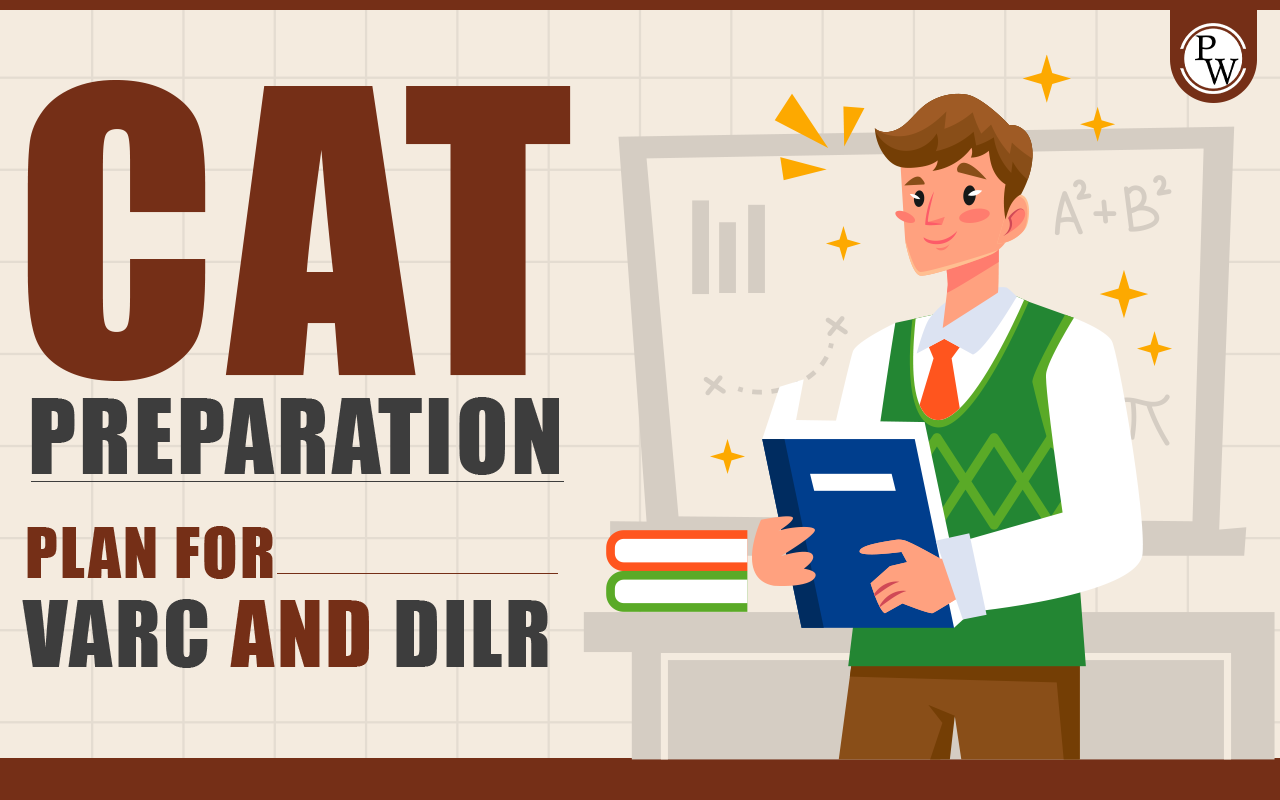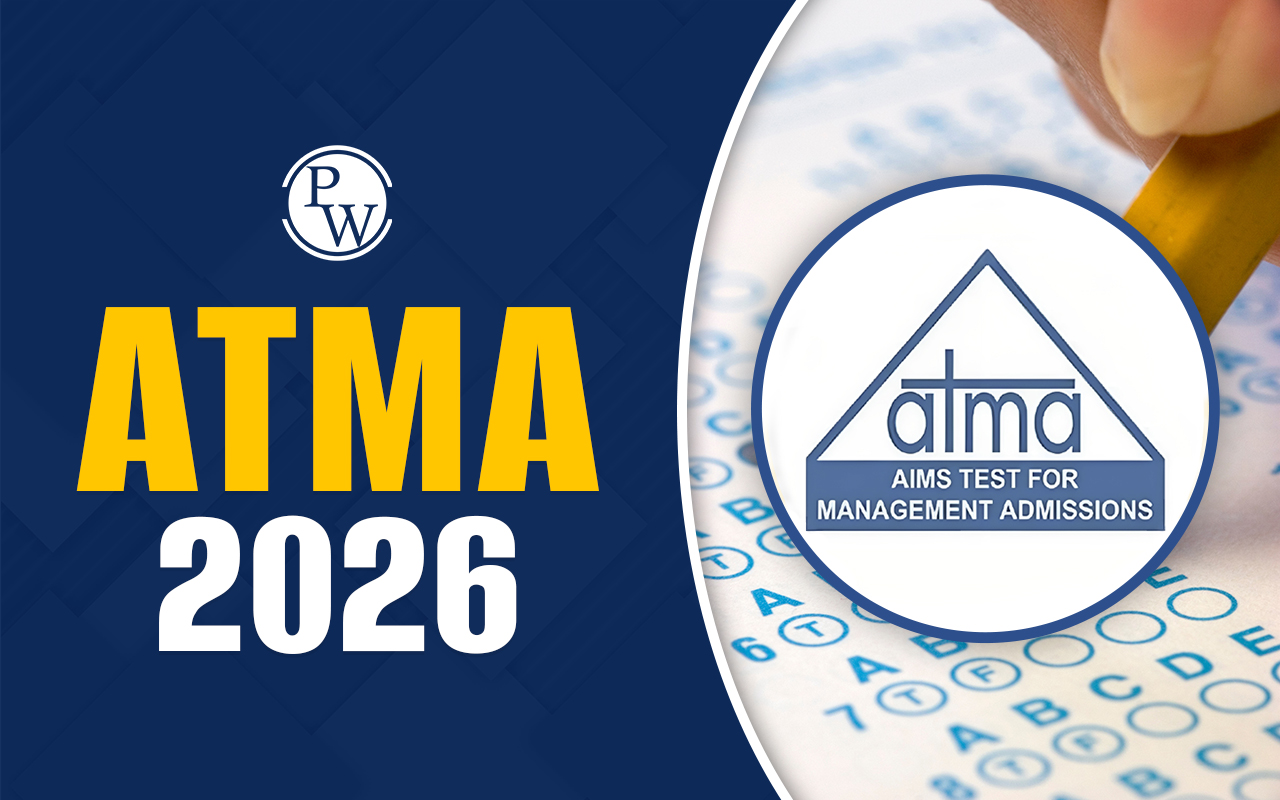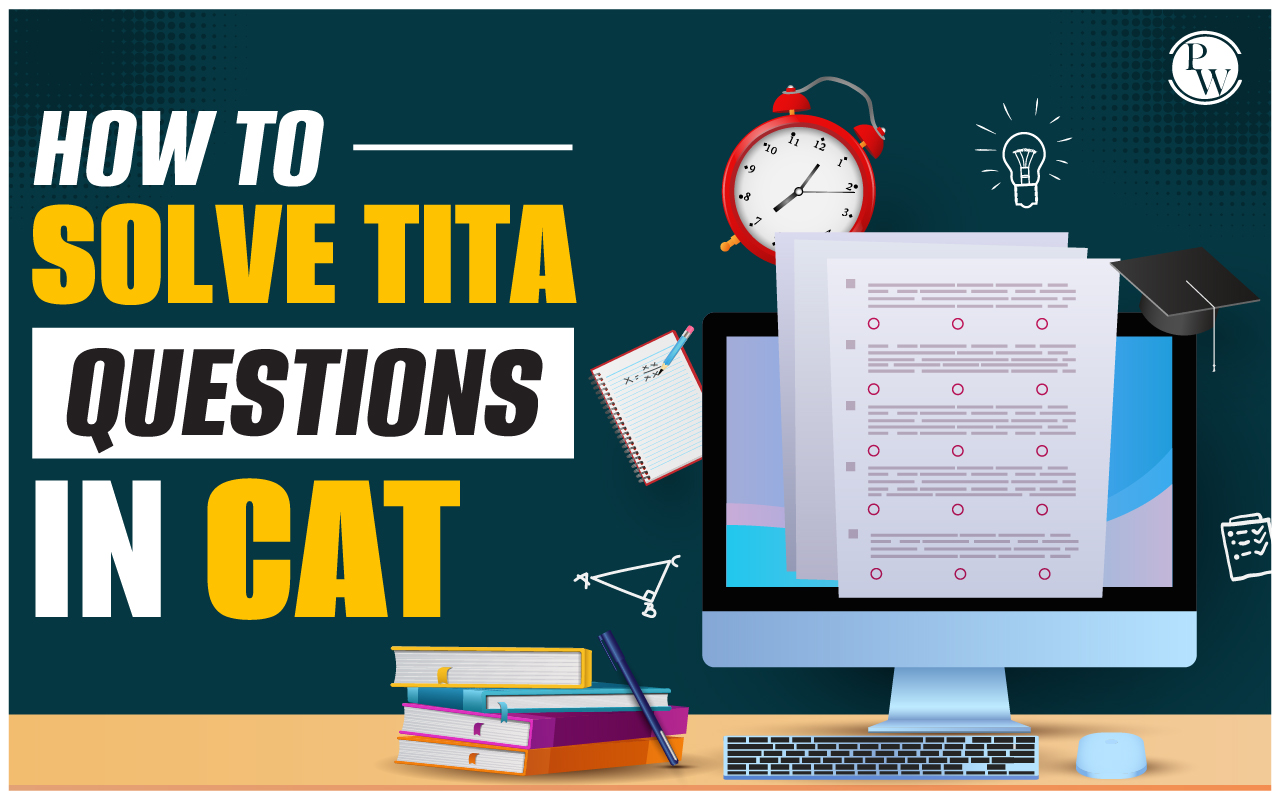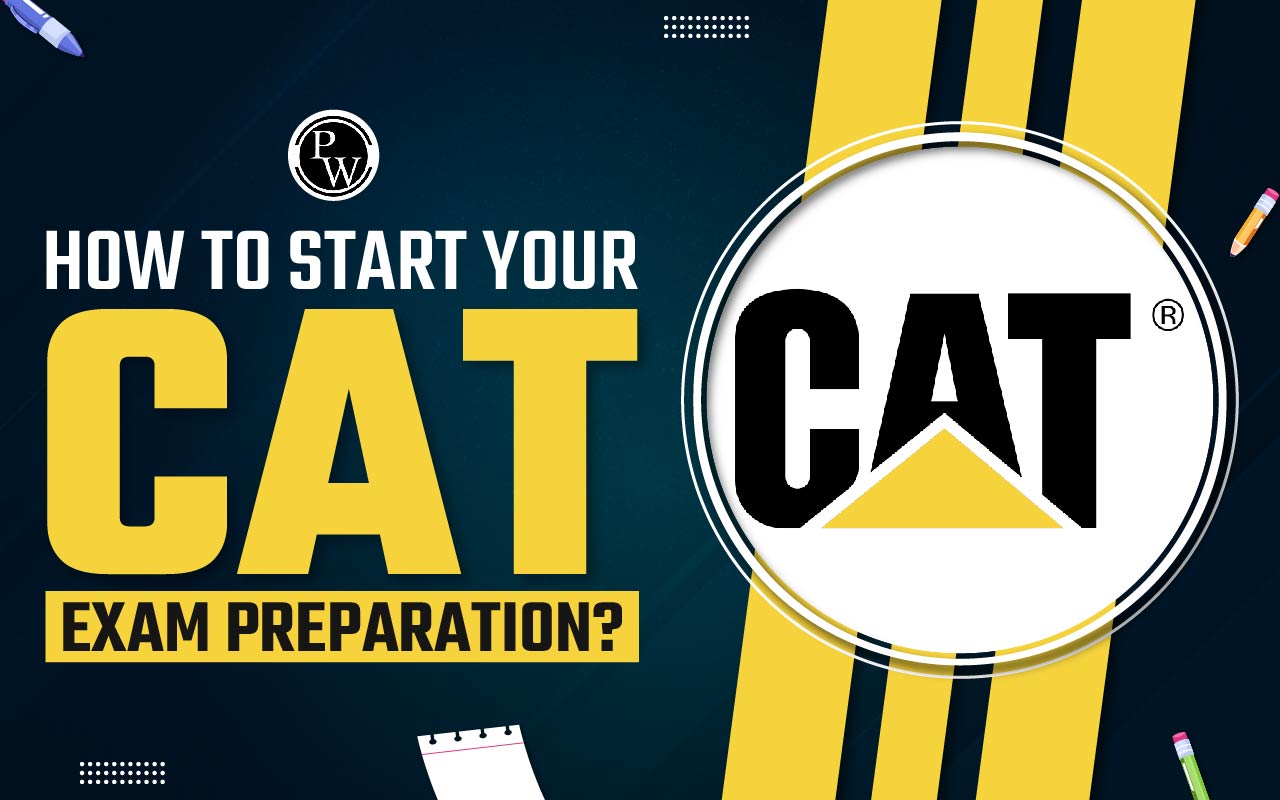
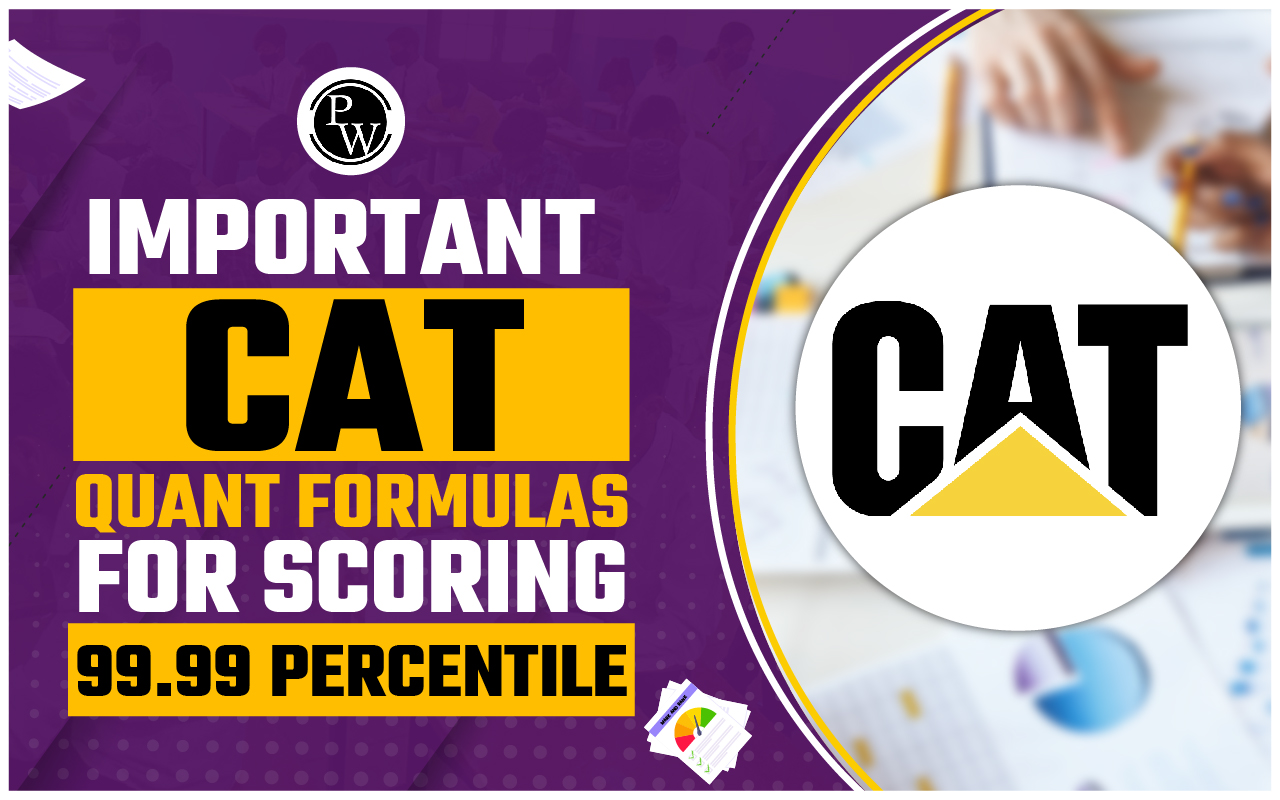
Important CAT Quant Formulas: Attaining a 99.99 percentile in the Quantitative Ability section of the Common Admission Test (CAT) is an impressive accomplishment. It requires not only smart preparation but also a solid understanding of important mathematical formulas.
Aspirants explore these key formulas that are essential for achieving exceptionally high scores in the CAT exam. Mastering these formulas and their applications can enhance problem-solving skills, improve accuracy, and increase the chances of achieving an outstanding percentile in CAT exam.What is the CAT Quant section in the CAT 2025 Exam?
The CAT Quantitative Ability section in the CAT exam is really important and carries a big part in CAT preparation. It covers a lot of topics, from percentages to algebra, checking how well candidates know their basic math. This section has different topics like Arithmetic, Number Systems and Modern Math, Geometry and Allied Topics, and Algebra and Miscellaneous topics.| CAT Quantitative Ability section in the CAT exam | |
| Category | Information |
| Exam Section | CAT Quantitative Ability |
| Importance | Crucial component with significant weight in CAT preparation |
| Syllabus Coverage | Vast syllabus including percentages, algebra, and more |
| Topics |
|
|
|
|
|
|
|
| Preparation Focus | Strong understanding of basic mathematical concepts and formulas |
| Preparation Strategy |
|
|
|
|
|
| Goal | Enhance quantitative aptitude skills and increase chances of scoring high |
Important CAT Quant Formulas for Scoring 99.99 Percentile
To score 99.99 percentile in CAT, mastering key formulas is crucial. Some important CAT Quant formulas include:- Percentage Change: Percentage Change = ((New Value – Old Value) / Old Value) × 100
- Simple Interest: Simple Interest (SI) = (Principal × Rate × Time) / 100
- Compound Interest: Compound Interest (CI) = P(1 + R/n)^(nt)
- Profit and Loss: Profit = Selling Price – Cost Price, Loss = Cost Price – Selling Price
- Average: Average = (Sum of all terms) / (Number of terms)
- Ratio and Proportion: If a : b = c : d, then (a/b) = (c/d)
- Quadratic Equation: For ax² + bx + c = 0, x = (-b ± √(b² – 4ac)) / 2a
- Arithmetic Progression (AP) Sum: Sum = n/2 * (First Term + Last Term)
- Geometric Progression (GP) Sum: Sum = a * (1 – r^n) / (1 – r)
- Distance Traveled when speed and time are given: Distance = Speed × Time
- Time taken to cover a certain distance at different speeds: Time = Speed × Distance

Arithmetic Formulas:
- Percentage Change: Percentage Change = ((New Value - Old Value) / Old Value) × 100
- Simple Interest: Simple Interest (SI) = (Principal × Rate × Time) / 100
- Compound Interest: Compound Interest (CI) = P(1 + R/n)^(nt) (where P is principal, R is rate, n is number of times compounded annually, t is time in years)
- Profit and Loss: Profit = Selling Price - Cost Price Loss = Cost Price - Selling Price
- Average: Average = (Sum of all terms) / (Number of terms)
- Ratio and Proportion: If a : b = c : d, then (a/b) = (c/d)
- Partnership: Ratio of investment × Time = Share in Profit or Loss
Algebra Formulas:
- Quadratic Equation: For ax² + bx + c = 0, x = (-b ± √(b² - 4ac)) / 2a
- Arithmetic Progression (AP) Sum: Sum = n/2 * (First Term + Last Term)
- Geometric Progression (GP) Sum: Sum = a * (1 - r^n) / (1 - r), where a is the first term and r is the common ratio
- Binomial Theorem: (a + b)^n = nC0 * a^n + nC1 * a^(n-1)b + ... + nCn * b^n
- Factorization: a² - b² = (a + b)(a - b) (a + b)² = a² + 2ab + b²
- Linear Equations: ax + by = c Solve for x: x = (c - by) / a Solve for y: y = (c - ax) / b
- Inequalities: If a > b, then a + c > b + c and ac > bc (for positive c)
Geometry Formulas:
- Area of Triangle: Area = 0.5 * Base * Height
- Perimeter of Rectangle: Perimeter = 2(Length + Width)
- Circumference of Circle: Circumference = 2πr (r is the radius)
- Area of Circle: Area = πr²
- Volume of Cylinder: Volume = πr²h (h is the height)
- Pythagorean Theorem: In a right triangle, a² + b² = c²
- Area of Trapezoid: Area = 0.5 * (Sum of parallel sides) * Height
Number System Formulas:
- Divisibility Rule by 2: A number is divisible by 2 if its units digit is even (0, 2, 4, 6, 8).
- Divisibility Rule by 3: A number is divisible by 3 if the sum of its digits is divisible by 3.
- Divisibility Rule by 9: A number is divisible by 9 if the sum of its digits is divisible by 9.
- Prime Factorization: Expressing a number as a product of prime numbers.
- LCM (Least Common Multiple): LCM of a and b = (a * b) / GCD(a, b)
- HCF (Highest Common Factor): HCF of a and b = Greatest common divisor of a and b.
- Prime Numbers: Natural numbers greater than 1 that have no positive divisors other than 1 and themselves.
Time, Speed, and Distance Formulas:
- Speed: Speed = Distance / Time
- Relative Speed: Speed of A + Speed of B
- Time taken to cover a distance at average speed: Time = Total Distance / Average Speed
- Distance Travelled when speed and time are given: Distance = Speed × Time
- Time taken to cover a certain distance at different speeds: Time = Distance / Speed
- Time taken to meet when moving towards each other: Time = Distance / Relative Speed
- Time taken to meet when moving in the same direction: Time = Relative Distance / Relative Speed
Also Read: Best online coaching for CAT MBA Entrance Exam
What topics are covered in the CAT Quant Section?
The CAT Quantitative Aptitude section covers many important topics you need to know for the exam. Here are some key ones listed below:- Algebra: This includes things like equations, inequalities, polynomials, functions, and quadratic equations. Understanding algebra is really important for solving problems and using logical reasoning.
- Arithmetic: This covers basic operations like percentages, ratios, averages, and proportions. It's the starting point for lots of quantitative problems.
- Number System: This involves integers, fractions, decimals, prime numbers, LCM, and HCF. Knowing number properties is super important for solving problems about divisibility and factors.
- Modern Math: This part includes set theory, permutations, combinations, and probability. You'll use these ideas when dealing with data interpretation and logical reasoning.
- Geometry & Mensuration: This deals with shapes, sizes, properties of space, areas, volumes, and angles. Your ability to understand space is tested through geometry problems in CAT.
- Trigonometry: This focuses on the relationships between angles and sides of triangles. Trigonometry is used when solving problems about heights, distances, and geometry.
- Permutation & Combination: This involves arranging and selecting objects without thinking about order. These ideas come in handy when dealing with counting problems and probability scenarios.
- Probability: This deals with how likely events are to happen and includes probability distributions, conditional probability, and Bayes' theorem. It's crucial for solving problems that involve chance and uncertainty.
What is the difference between problem-solving and data sufficiency in the CAT Quant Section?
In the CAT Quantitative Aptitude section, the main difference between problem-solving and data sufficiency lies in the types of questions and how they are evaluated:- Problem-Solving:
- These questions are structured similarly to CAT but are generally at a slightly easier level. Candidates need to directly solve mathematical problems.
- The focus here is on accuracy, and candidates can check their answers before submitting.
- Problem-solving questions test mathematical abilities without the need to evaluate data sufficiency.
- Data Sufficiency:
- On the other hand, data sufficiency questions are unique to GMAT.
- Candidates are given two statements and must decide if the information provided is enough to solve a problem.
- This type of question evaluates critical thinking and reasoning skills by assessing the sufficiency of information, rather than requiring direct problem-solving.
What are some common mistakes to avoid in data sufficiency questions?
Here are some common mistakes to avoid in Data Sufficiency questions, like those in the CAT exam:- Assuming Extra Information: Don't guess or think about information that isn't given in the question. Stick to the details provided and don't add any extra assumptions.
- Ignoring Statements: Every statement in a Data Sufficiency question is important. If you ignore or don't think carefully about any statement, you might come to the wrong conclusion. Take the time to assess all the information given.
- Focusing Only on the Answer: In Data Sufficiency questions, the goal isn't to solve the problem but to figure out if the given information is enough to solve it. Don't get stuck trying to find the answer; instead, focus on checking if the provided information is sufficient.
- Not Checking Both Statements: It's a common mistake to think one statement alone is enough without looking at both. Always check if each statement by itself has enough information before making a decision.
Physics Wallah offers online coaching for the Common Admission Test (CAT) through their MBA Pioneer Pro 2024 batch . This batch includes online classes for management examinations for 2024, including CAT. Join now to enhance your preparation journey.
https://www.youtube.com/watch?v=E4l5wAlSF8s| CAT Exam Important Links | |
| CAT Score Vs Percentile | CAT Percentile Predictor |
| CAT Syllabus for MBA | CAT Exam 2025 |
| CAT Exam Analysis 2023 for Slot 1, Slot 2, Slot 3 | CAT Exam Pattern 2025 |
Crack the Analytical & Logical Reasoning section of SNAP FAQs
Why are CAT Quant formulas important?
CAT Quant formulas are crucial as they provide a quick and efficient way to solve complex mathematical problems, contributing significantly to achieving a high percentile.
How can mastering these formulas improve my percentile?
Mastering these formulas enhances problem-solving skills, improves accuracy, and increases efficiency, leading to better performance in the Quantitative Ability section.
Do I need to memorize all the formulas?
While memorizing all formulas is not necessary, having a solid understanding of key formulas for arithmetic, algebra, geometry, and other topics is highly beneficial.
Can I solely rely on formulas to score well?
No, alongside formulas, it's crucial to practice applying them to different types of problems. Understanding the context and strategy for using formulas is equally important.
Are these formulas applicable only to CAT exams?
While specifically designed for CAT, many of these formulas are fundamental in various quantitative aptitude exams, making them versatile for different competitive tests.
Talk to a counsellorHave doubts? Our support team will be happy to assist you!

Free Learning Resources
PW Books
Notes (Class 10-12)
PW Study Materials
Notes (Class 6-9)
Ncert Solutions
Govt Exams
Class 6th to 12th Online Courses
Govt Job Exams Courses
UPSC Coaching
Defence Exam Coaching
Gate Exam Coaching
Other Exams
Know about Physics Wallah
Physics Wallah is an Indian edtech platform that provides accessible & comprehensive learning experiences to students from Class 6th to postgraduate level. We also provide extensive NCERT solutions, sample paper, NEET, JEE Mains, BITSAT previous year papers & more such resources to students. Physics Wallah also caters to over 3.5 million registered students and over 78 lakh+ Youtube subscribers with 4.8 rating on its app.
We Stand Out because
We provide students with intensive courses with India’s qualified & experienced faculties & mentors. PW strives to make the learning experience comprehensive and accessible for students of all sections of society. We believe in empowering every single student who couldn't dream of a good career in engineering and medical field earlier.
Our Key Focus Areas
Physics Wallah's main focus is to make the learning experience as economical as possible for all students. With our affordable courses like Lakshya, Udaan and Arjuna and many others, we have been able to provide a platform for lakhs of aspirants. From providing Chemistry, Maths, Physics formula to giving e-books of eminent authors like RD Sharma, RS Aggarwal and Lakhmir Singh, PW focuses on every single student's need for preparation.
What Makes Us Different
Physics Wallah strives to develop a comprehensive pedagogical structure for students, where they get a state-of-the-art learning experience with study material and resources. Apart from catering students preparing for JEE Mains and NEET, PW also provides study material for each state board like Uttar Pradesh, Bihar, and others
Copyright © 2025 Physicswallah Limited All rights reserved.
Get App






